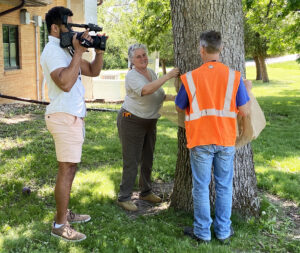Art Kabelowsky, DNR Forest Health outreach and communications specialist
Arthur.Kabelowsky@wisconsin.gov or 608-335-0167
Add “YouTube Influencer” to the long list of career accomplishments of Andrea Diss-Torrance, Ph.D.
With the spongy moth caterpillar population on the rise in many areas of Wisconsin this season, the Wisconsin Department of Natural Resources stepped into action last month.

Daniel Robinson, a videographer/editor with the DNR’s Office of Communications, films Dr. Andrea Diss-Torrance, Forest Health invasive forest insects program coordinator, and Scott Schumacher, Forest Health plant pest and disease specialist, as they place a burlap band around a tree to capture spongy moth caterpillars. Photo: Wisconsin DNR.
The Forest Health team conceived a video meant to demonstrate how to use burlap bands to trap spongy moth caterpillars, accompanying a news release from Bill McNee, Forest Health specialist for the Southeast region, warning that this year’s caterpillar population could be the highest in years.
The DNR’s Office of Communications sent videographer/editor Daniel Robinson to the Forest Health Lab to shoot the video.
Diss-Torrance, Forest Health’s invasive forest insects program coordinator, appeared in the video and narrated it, with help from Scott Schumacher, Forest Health plant pest and disease specialist.
The shoot took less than two hours and Robinson had it edited and posted to the DNR’s YouTube channel by the following afternoon, accompanying the news release.
Hillstrom Part Of Spongy Moth Webinar
Mike Hillstrom, DNR forest health specialist in Fitchburg, recently participated in an hour-long webinar focusing on spongy moth.
The webinar is available for viewing on YouTube.
Hillstrom joined P.J. Liesch, University of Wisconsin-Madison entomologist, to discuss the lifecycle of spongy moths and multiple options for management — including how to decide if you need to take action, and if so, what sort of tools can be used.
They emphasized that chemical options are a last resort, as consideration must be given to their impact on non-target organisms and the surrounding environment. Those who choose to use chemical options were reminded that the law requires them to follow the safety and application information on the label.
